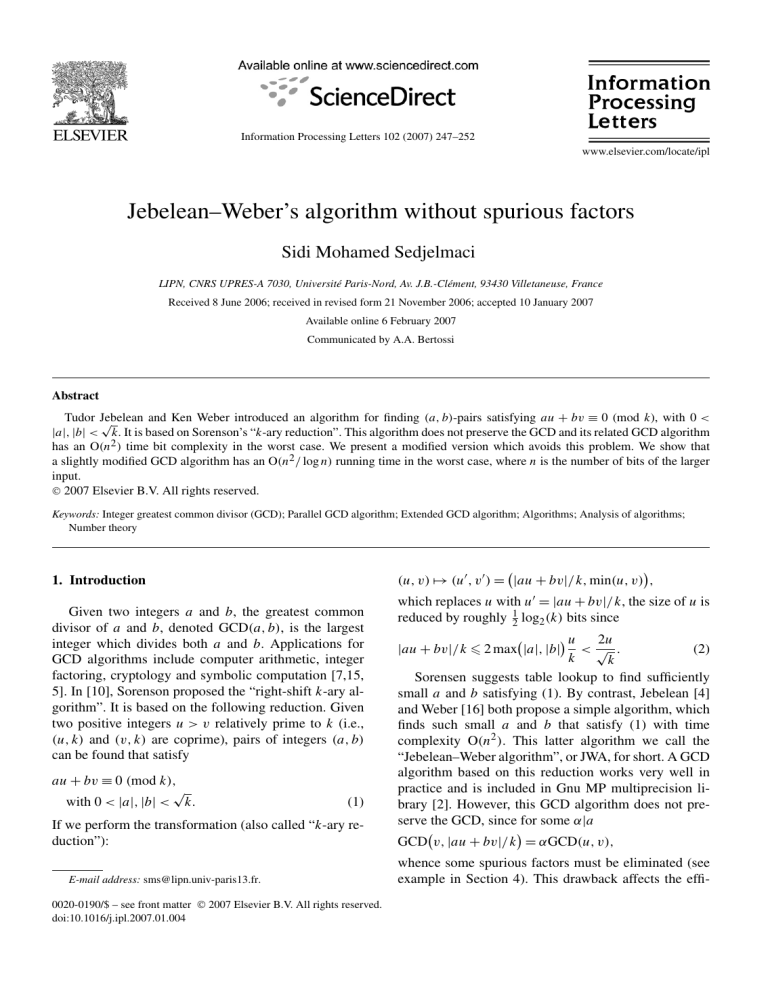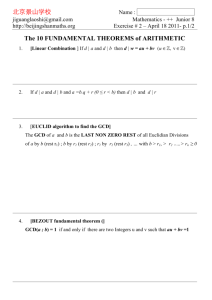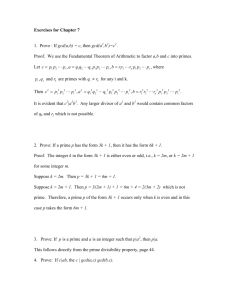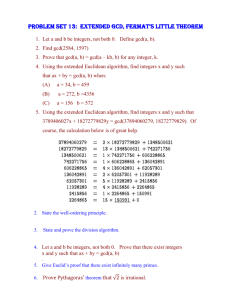
Information Processing Letters 102 (2007) 247–252
www.elsevier.com/locate/ipl
Jebelean–Weber’s algorithm without spurious factors
Sidi Mohamed Sedjelmaci
LIPN, CNRS UPRES-A 7030, Université Paris-Nord, Av. J.B.-Clément, 93430 Villetaneuse, France
Received 8 June 2006; received in revised form 21 November 2006; accepted 10 January 2007
Available online 6 February 2007
Communicated by A.A. Bertossi
Abstract
Tudor Jebelean
and Ken Weber introduced an algorithm for finding (a, b)-pairs satisfying au + bv ≡ 0 (mod k), with 0 <
√
|a|, |b| < k. It is based on Sorenson’s “k-ary reduction”. This algorithm does not preserve the GCD and its related GCD algorithm
has an O(n2 ) time bit complexity in the worst case. We present a modified version which avoids this problem. We show that
a slightly modified GCD algorithm has an O(n2 / log n) running time in the worst case, where n is the number of bits of the larger
input.
© 2007 Elsevier B.V. All rights reserved.
Keywords: Integer greatest common divisor (GCD); Parallel GCD algorithm; Extended GCD algorithm; Algorithms; Analysis of algorithms;
Number theory
(u, v) → (u , v ) = |au + bv|/k, min(u, v) ,
1. Introduction
Given two integers a and b, the greatest common
divisor of a and b, denoted GCD(a, b), is the largest
integer which divides both a and b. Applications for
GCD algorithms include computer arithmetic, integer
factoring, cryptology and symbolic computation [7,15,
5]. In [10], Sorenson proposed the “right-shift k-ary algorithm”. It is based on the following reduction. Given
two positive integers u > v relatively prime to k (i.e.,
(u, k) and (v, k) are coprime), pairs of integers (a, b)
can be found that satisfy
au + bv ≡ 0 (mod k),
√
with 0 < |a|, |b| < k.
(1)
If we perform the transformation (also called “k-ary reduction”):
E-mail address: sms@lipn.univ-paris13.fr.
0020-0190/$ – see front matter © 2007 Elsevier B.V. All rights reserved.
doi:10.1016/j.ipl.2007.01.004
which replaces u with u = |au + bv|/k, the size of u is
reduced by roughly 12 log2 (k) bits since
u
2u
(2)
|au + bv|/k 2 max |a|, |b| < √ .
k
k
Sorensen suggests table lookup to find sufficiently
small a and b satisfying (1). By contrast, Jebelean [4]
and Weber [16] both propose a simple algorithm, which
finds such small a and b that satisfy (1) with time
complexity O(n2 ). This latter algorithm we call the
“Jebelean–Weber algorithm”, or JWA, for short. A GCD
algorithm based on this reduction works very well in
practice and is included in Gnu MP multiprecision library [2]. However, this GCD algorithm does not preserve the GCD, since for some α|a
GCD v, |au + bv|/k = αGCD(u, v),
whence some spurious factors must be eliminated (see
example in Section 4). This drawback affects the effi-
248
S.M. Sedjelmaci / Information Processing Letters 102 (2007) 247–252
ciency of the GCD algorithm, at least for small integers (1000 bits). In this present work we show how
a slightly modified version of JWA easily avoids this
problem. Not only is this modified version desirable
for GCD computations but it is also needed in many
other applications, such as Jacobi symbol computation
or modular inverse, to mention only a few [7].
The paper is organized as follows. Notations and definitions are given in Section 2. In Section 3, we recall
the Jebelean–Weber algorithm and propose a modified
version. Section 4 deals with the correctness. In Section 5 we describe our algorithm, study its time complexity, and report on preliminary experiments. We conclude with some remarks in Section 6.
2. Notation
Throughout this paper, we restrict ourselves to the
set of non-negative integers. Let u and v be two such
(non-negative) integers; u and v are, respectively, n-bits
and p-bits numbers with u v 1. Let k be an integer
parameter s.t. k 4.
Given a non-negative integer x ∈ N , 2 (x) represents
the number of significant bits of an non-negative integer x, not counting leading zeros: 2 (x) = log2 (x) +1,
if x 1 and 2 (0) = 0. So n = 2 (u), p = 2 (v)
and p satisfies 2p−1 v < 2p . We let ρ = ρ(u, v) =
2 (u) − 2 (v) + 1. Thus, we obtain 2ρ−2 < u/v < 2ρ .
Let a, b be positive integers, the integer x = a mod b
is the unique non-negative integer x such that 0 x b − 1 and x − a is divisible by b. Note that this notation still holds when a < 0. If b is relatively prime to k,
then r = a/b mod k is the unique non-negative integer
r such that 0 r k − 1 and rb ≡ a (mod k).
As noticed by many authors the main difficulty in
GCD algorithms happens when the input data u and
v are roughly of the same size [10,4,16]. So we shall
assume√that when Sorenson’s reduction is applied:
u/v < k. Otherwise, we usually apply a more efficient reduction: an Euclidean step or the bmod, defined
as: bmod(u, v) = |u − (u/v mod 2ρ )v|/2ρ .
The extended version of Euclid GCD algorithm is
noted EEA [5]. It is tightly linked with continued fractions [3,5] and is important for its multiple applications
in cryptology and computer algebra.
3. The algorithms
3.1. JWA: The Jebelean–Weber algorithm
First we recall the JWA as stated in [16].
Input: x, y > 0, k 4, and gcd(k, x) =
√ gcd(k, y) = 1.
Output: (n, d) such that 0 < n, |d| < k, and
ny ≡ dx mod k.
r := x/y mod k;
f1 = (n1 , d1 ) := (k, 0);
f2 = (n2 , d2 ) :=
√ (r, 1);
while n2 k do
f1 := f1 − n1 /n2 f2 ;
swap (f1 , f2 );
endwhile
return f2
Fig. 1. The Jebelean–Weber algorithm.
When (n, d) is the output result of JWA, the pair
(a, b) = (d, −n) (or (−d, n)) satisfies the property au +
bv = 0 mod k. The algorithm JWA is nothing but the
extended version of Euclid EEA applied to the pair
(k, u/v mod k), where only one column is added instead of two for EEA (see [5]), and they only differ on
their exit test.
3.2. The modified Jebelean–Weber algorithm: M-JWA
We give in Fig. 2 a modified version that avoids spurious factors introduced in JWA.
Input: x, y > 0, k 4 such that gcd(k, x) = gcd(k,y) = 1.
n d
Output: A 2 × 2 integer matrix M = M(x, y, k) = n1 d 1
2 2
√
such that 0 < n2 , |d2 | < k, n2 y ≡ d2 x (mod k) and
n1 y ≡ d1 x (mod k).
r := x/y mod k;
f1 = (n1 , d1 ) := (k, 0);
f2 = (n2 , d2 ) :=
√ (r, 1);
while n2 k do
f1 := f1 − n1 /n2 f2 ;
swap (f1 , f2 );
endwhile n d
return M = n1 d 1
2 2
Fig. 2. The modified Jebelean–Weber algorithm: M-JWA.
The new transformation associated with the output
matrix of M-JWA is defined by (u, v) ← (R1 , R2 ) with:
R1 = |n1 v − d1 u|/k
R2 = |n2 v − d2 u|/k.
and
(3)
(4)
We will prove in the next section that the transformation (u, v) ← (R1 , R2 ) preserves the GCD, i.e.:
GCD(R1 , R2 ) = GCD(u, v) and avoids the spurious
factors of algorithm JWA.
S.M. Sedjelmaci / Information Processing Letters 102 (2007) 247–252
4. Correctness
Before proving that indeed, M-JWA preserves the
GCD, we first recall below some well-known properties [3,5] of EEA that are also valid for JWA as well
as for M-JWA. Let (ns , ds )s1 be the pair of sequences
corresponding to the successive results of f2 in JWA or
M-JWA and (n0 , d0 ) = (k, 0); then ∀s 1 we have
•
•
•
•
ns > 0 and ds ds+1 < 0,
ns /ds ≡ x/y (mod k),
ns ds+1 − ns+1 ds = (−1)s k,
(ns )s is decreasing and (|ds |)s is increasing.
Lemma 4.1. The output of JWA
√ satisfies n2 y − d2 x ≡
0 (mod k) and 0 < n2 , |d2 | < k n1 .
Proof. (See [16].) In the last iteration i √of JWA or
M-JWA ni must meet the condition ni < k < ni−1 .
Hence, since ni−1√|di | + ni |di−1 | = k, ni−1 |di | k and
|di | < k/ni−1 k.√Moreover, we have at the end of
the while loop n2 < k n1 . 2
We prove in the following that the output integer matrix of M-JWA enjoys more interesting properties.
Lemma 4.2. Let u v 1 and k 4 be three positive integers such
gcd(u, k) = gcd(v, k) = 1 and
that
√
u/v < k. Let ac bd be the output integer matrix of
M-JWA with (u, v) as inputs, then G = (|du − cv|)/k is
a positive integer such that 0 G v.
Proof. First, G is an integer √
since c/d ≡ a/b ≡
u/v mod k = r. Moreover, if r <
√ k then c = k, d = 0
and G = v. Otherwise k > r k and since |d| |b|,
we proceed in two cases:
Case 1: If |b| = |d|, then this case only happens only
when
√b = −1, d = 1, c = r and k/r = 1. Since k >
c > k > u/v, we obtain
G = |u − cv|/k = |u/v − c|(v/k)
= (c − u/v)(v/k) < (c/k)v < v.
Case 2: If |b| > |d|. We have G (|d|u + cv)/k =
(|d|u/kv + c/k)v. Let us prove that |d|u/kv + c/k < 1,
i.e., u/v < (k − c)/|d|. From |b| > |d| we obtain
√
(|b| − 1)/|d| 1. From Lemma 4.1 we have c k
and using the relation k = c|b| + a|d|, we obtain the
result
249
k − c c|b| + a|d| − c
=
|d|
|d|
√
|b| − 1
+ a k > u/v.
=c
|d|
2
Lemma 4.3. Let u v 1 and k 1 be three integers
such that GCD(u, k) = GCD(v, k) = 1. Let M = ac bd
be an integer matrix with | det M| = |cb − ad|
= k.
If there exist two integers R1 , R2 satisfying k RR21 =
M vu , then GCD(R1 , R2 ) = GCD(u, v).
Proof. Let α = GCD(u, v) and β = GCD(R1 , R2 ) then
kR1 = (cu + dv) so α|kR1 but GCD(u, k) = 1 then
GCD(α, k) = 1 and α|R1 . Similarly kR2 = (au + bv)
and α|R2 . Hence α|β. Moreover, since |cb − ad| =
k = 0, M −1 exists and
R1
u
= k × M −1
R2
v
bR1 − dR2
= k × ε/k ×
, with ε = ±1,
−aR1 + cR2
hence β|α and the result α = β.
2
Example. If k = 2ρ , then the transformation (u, v) :=
(v, bmod(u, v)) preserves
the GCD since the associated
k
, with r = u/v mod k.
matrix is M = 01 −r
Remark. It is worth to note that this lemma generalizes a well-known result in the case k = ±1, i.e., if
u
R1
R2 = M v , and det M = ±1 then GCD(R1 , R2 ) =
GCD(u, v). This situation occurs in EEA.
A similar method can be applied to eliminate spurious factors for the left-shift k-ary GCD of Sorenson [10]. Following the same approach,
apair of integers (c, d) can be found such that det ac bd = ±1.
Proposition 4.1. Let M(u, v, k) = nn12 dd21 be the output
integer matrix
√ of M-JWA, given input u, v and k such
that u/v < k. If
|n1 v − d1 u|/k
R1
=
,
R2
|n2 v − d2 u|/k
then R1 and R√
2 are two integers satisfying 0 R1 v,
0 R2 2u/ k and GCD(R1 , R2 ) = GCD(u, v).
Proof. We have
R1
u
k
=N
,
v
R2
where N is one of the four following matrices
250
S.M. Sedjelmaci / Information Processing Letters 102 (2007) 247–252
Table 1
Spurious factors in JWA with Fibonacci pair of inputs (FN , FN −1 )
N
Spurious factor
300
1000
2000
3000
4000
5000
6000
9000
5
151875
122542875
∼ 1.02 · 1015
∼ 2.37 · 1015
∼ 1.15 · 1019
∼ 2.74 · 1025
∼ 9.67 · 1043
N1 =
N3 =
−d1
−d2
n1
n2
−d1
d2
n1
−n2
d1 −n1
N2 =
,
d2 −n2
d1 −n1
or N4 =
.
−d2 n2
,
Then the result derives straightforwards from Lemmas 4.2, 4.3 and relation (2). 2
Example. Let (u, v) = (28865, 19203) and k = 26
= 64. Note that GCD(u, v) = 1. We obtain in turn
−1
.
u/v mod k = 1/3 mod 64 = 43, and M = 21
1 3
Hence R1 = |u + 21v|/64 = 6752, and R2 = |3u − v|/
64 = 1053. The JWA algorithm uses the transformation (u, v) ← (v, R2 ). However GCD(v, R2 ) =
GCD(19203, 1053) = 3 = GCD(u, v), while, with
M-JWA algorithm, we obtain GCD(R1 , R2 ) =
GCD(6752, 1053) = GCD(u, v) = 1. The spurious factor 3 has been eliminated. Table 1 gives some examples
of spurious factors with Fibonacci pair inputs.
5. The M-JWA GCD algorithm
An easy GCD algorithm can be designed by simply
alternating M-JWA reductions and Euclidean reductions to achieve an O(n2 / log n) running time in the
worst case. This algorithm is similar to ModGenBin
algorithm of Sorenson [12], however the difference is
that there are no spurious factors at all. We first recall
some results on basic arithmetic (see [10,11] for more
details).
Lemma 5.1. Let x, y and k = 2m , m 2 be three
positive integers with x > y. If y k, then xy, x/y
and x mod y can be computed in O(log x) bit operations. If y > k, then xy can be computed in O(log x +
(log x log y)/ log k) bits operations. Moreover, x/y
and x mod y can be computed in O(log x + (logx/y ·
log y)/ log k) bits operations. These results require precomputed tables of size O(k 2 log k) bits. It requires at
most O(k 2 log2 k) bit operations to compute these tables.
Proof. See [12].
2
If the length n of the input u is such that log n >
W/2, where W = 32 or 64, then we allow the parameter k to grow with the length n: log k = (log n). For
example, as in [12,13], we can choose the parameter k
such that k = n0.4 .
Input: u v 3, two odd integers.
Output: gcd(u, v).
k = 232 or k = 264 ;
n := log2 (u) + 1;
if (n0.4 > k) then
m := 0.4 log2 n + 1;
m := m + (m mod 2); k := 2m ;
Precompute tables (see Lemma 5.1);
endif
while uv = 0 do
if u < v then
√ (u, v) := (v, u);
if u/v
<
k then
cd
ab
:= M-JWA(u, v, k);
u := |du − cv|/k;
v := |bu − av|/k;
else (u, v) := (v, u mod v);
makeodd(u); makeodd(v);
endwhile
return u + v;
Fig. 3. The modified Jebelean–Weber GCD algorithm: M-JWA-GCD.
The makeodd(x) function removes all the powers
of 2 from the integer x. M-JWA(u, v, k) is the output
matrix of M-JWA algorithm described in Fig. 2.
5.1. Complexity analysis
Theorem 5.2. If u and v are two positive integers
of at most n bits in length, then M-JWA-GCD computes gcd(u, v) with a worst case running time of
O(n2 / log n).
Proof. The proof is similar to those described in [10–
12]. First we assume that only M-JWA reductions occur.
The computation of the matrix M-JWA(u, v, k) costs
O(log2 k). The computation of |du − cv| and |bu − av|
can be computed in O(n) time. Since there are, at most,
O(n/ log k) iterations, then we obtain O((n/ log k) ×
(n + log2 k)) = O(n2 / log n) running time.
Now, we assume that only Euclidean steps occur.
Let vi and qi , i = 1, 2, . . . , s, be, respectively, the remainders and quotients sequences obtained in Euclid
algorithm, with s = O(n/ log k). The running time is
bounded by (up to a constant)
S.M. Sedjelmaci / Information Processing Letters 102 (2007) 247–252
Table 2
CPU times in microseconds for M-JWA and JWA gcd algorithms with
104 random integers of SIZE words of 32 bits
SIZE
M-JWA
JWA
10
20
30
40
50
70
39.4
117.7
150.1
246.0
353.9
588.7
42.3
118.4
153.4
240.8
339.5
563.0
s
log vi log qi
i=1
log k
+ O(log vi ) + O(log qi )
s
n+1 log qi + sn
log k
i=1
= O(n / log n),
2
since log k = (log n) and si=1 qi 2n .
Finally, the precomputed tables require a memory
space of O(k 2 log k) = O(n0.8 log n) bits, which is no
more than the length of the inputs u and v. It also needs
at most O(k 2 log2 k) = O(n0.8 log2 n) bit operations in
time to compute these tables. 2
5.2. Experiments
The implementation is written in GNU C Compiler
gcc, version 2.7 (Stallman, 1991 [2]) with the 3.1.1
GNU MP library on a Pentium IV, 3.1 GHz Dell PC,
running Linux system. The average times are in microseconds (µs). We used the same parameters for both
M-JWA-GCD and JWA-GCD and the code is not optimized. The experiments were done on N = 104 random numbers u and v of SIZE words of 32 bits, with
10 SIZE 70. We used k = 230 with M-JWA reduction for 2 (u) − 2 (v) 4, and Euclidean step
otherwise.
The results described in Table 2 show that M-JWAGCD has a slightly better running time for integers of
size less than 30 words of 32 bits. For larger inputs,
the parameter k = 230 was not suitable and we suggest
to experiment it with more M-JWA reductions, i.e., for
2 (u) − 2 (v) C, with C > 4 and larger parameter k,
i.e.: k = 264 .
6. Conclusion
We have shown that a slight modification easily
avoids the spurious factors introduced by JWA. Although in our experiments M-JWA is faster only for
251
integers less then 30 words of 32 bits, it makes the
complexity analysis much easier and helps to design
other Jebelean like GCD algorithms. Sorenson also proposed in [12] a small modification of the JWA algorithm but its GCD algorithm has an O(n2 / log n) running time on average, and O(n2 ) running time in the
worst case. We improve this result, since our algorithm
has an O(n2 / log n) running time in the worst case.
On the other hand, for very large integers, there are
many half-gcd like algorithms [1,6,8,14,15,9] that computes the GCD in O(n log2 n log log n) time, but all these
fast algorithms fall down to more basic algorithms at
some point of their recursion. Moreover, we observe
that Sorenson’s reduction (1) is basically a half-gcd like
procedure (consider k = 2n ) and the cofactors a and b in
relation (1) depend only on the least significant bits of
u and v. Therefore, one may consider to built a half-gcd
like algorithm based on a recursive Sorenson’s reduction. This is the direction we intend to next take our
research.
References
[1] A.V. Aho, J.E. Hopcroft, J.D. Ullman, The Design and Analysis
of Computer Algorithms, Addison-Wesley, 1974.
[2] GNU MP 4.1.2, online reference http://swox.com/gmp/manual/
index.html, 2002.
[3] G.H. Hardy, E.V. Wright, An Introduction to the Theory of Number, Oxford University Press, London, 1979.
[4] T. Jebelean, A generalization of the binary GCD algorithm, in:
Proc. of the International Symposium on Symbolic and Algebraic Computation (ISSAC’93), 1993, pp. 111–116.
[5] D.E. Knuth, The Art of Computer Programming, vol. 2, third ed.,
Addison-Wesley, 1981.
[6] D. Lichtblau, Half-GCD and fast rational recovery, in: Proc. of
the International Symposium on Symbolic and Algebraic Computation (ISSAC’2005), 2005, pp. 254–258.
[7] A.J. Manezes, P.C. van Oorschot, S.A. Vanstone, Handbook of
Applied Cryptography, vols. 1–2, second ed., CRC Press, 1997.
[8] A. Schönhage, Schnelle Berechnung von Kettenbruchentwicklugen, Acta Informatica 1 (1971) 139–144.
[9] M.S. Sedjelmaci, The accelerated Euclidean algorithm, Poster
talk presented at the International Symposium on Symbolic and
Algebraic Computation (ISSAC’2004), University of Cantabria,
Santander, Spain, July 4–7, 2004.
[10] J. Sorenson, Two fast GCD algorithms, J. of Algorithms 16
(1994) 110–144.
[11] J. Sorenson, An analysis of Lehmer’s Euclidean algorithm, in:
Proc. of the International Symposium on Symbolic and Algebraic Computation (ISSAC’95), 1995, pp. 254–258.
[12] J. Sorenson, An analysis of the generalized binary GCD algorithm, in: A. van der Poorten, A. Stein (Eds.), High Primes and
Misdemeanors, Lectures in Honour of Hugh Cowie Williams,
Banff, Alberta, Canada, AMS Math. Review 2005h:11279 41
(2004) 254–258, http://euclid.butler.edu/.
252
S.M. Sedjelmaci / Information Processing Letters 102 (2007) 247–252
[13] J. Sorenson, Lehmer’s algorithm for very large numbers, Poster
talk presented at ANTS VI, University of Vermont, USA, June
13–18, 2004.
[14] D. Stehle, P. Zimmermann, A binary recursive GCD algorithm,
in: Proc. of ANTS VI, University of Vermont, USA, June 13–18,
2004, pp. 411-425.
[15] J. von zur Gathen, J. Gerhard, Modern Computer Algebra, first
ed., Cambridge University Press, 1999.
[16] K. Weber, Parallel implementation of the accelerated integer
GCD algorithm, J. of Symbolic Computation (Special Issue on
Parallel Symbolic Computation) 21 (1996) 457–466.










